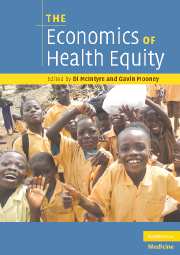Book contents
- Frontmatter
- Contents
- Contributors
- Biographies
- Acknowledgements
- Section 1 Introduction
- Section 2 Equity in general
- 2 Health and health inequalities in a neo-liberal global world
- 3 Governing the market in health care: the social and political requirements
- 4 Equity in the context of diversity of culture and diversity of economic systems
- 5 Beware of the libertarian wolf in the clothing of the egalitarian sheep: an essay on the need to clarify ends and means
- Section 3 Health service access
- Section 4 Equity and health systems
- Section 5 Lessons from individual countries
- Section 6 Future action
- Index
- References
2 - Health and health inequalities in a neo-liberal global world
Published online by Cambridge University Press: 22 August 2009
- Frontmatter
- Contents
- Contributors
- Biographies
- Acknowledgements
- Section 1 Introduction
- Section 2 Equity in general
- 2 Health and health inequalities in a neo-liberal global world
- 3 Governing the market in health care: the social and political requirements
- 4 Equity in the context of diversity of culture and diversity of economic systems
- 5 Beware of the libertarian wolf in the clothing of the egalitarian sheep: an essay on the need to clarify ends and means
- Section 3 Health service access
- Section 4 Equity and health systems
- Section 5 Lessons from individual countries
- Section 6 Future action
- Index
- References
Summary
Summary
Health inequalities are central to current health policy internationally and in many nations. As health improvements have slowed, the extent and depth of health inequalities in the developed world have become too obvious to ignore. At the same time the profound differences in health between the developed and underdeveloped world, between obesity for some and starvation for others, has created a moral crisis. Yet, the often proclaimed solution to human problems, neo-liberal free trade producing economic growth and improved human wellbeing, i.e., market fundamentalism, has proven a failure. The dogmatic application of neo-liberal doctrines perversely increases those social inequalities that are among the basic causes of health inequities. The issue then becomes one of creating conditions that would permit more variegated approaches to improving human well-being and reducing inequalities. Ironically, the dynamics of globalization, broadly defined as a view of human beings sharing the same planet and the same fate, has produced opposition to the untrammelled dominance of multinational corporations and the states they influence or control. If we know something about who and what the enemy is, we do not as yet know solutions other than doing something differently and more humanely. There are examples of countries and areas that do better than others at translating economic growth into improvements in human welfare. We can learn from them. Yet the onus remains on us to do whatever is within our capabilities to develop a more just and equal world.
- Type
- Chapter
- Information
- The Economics of Health Equity , pp. 13 - 35Publisher: Cambridge University PressPrint publication year: 2007
References
- 6
- Cited by



